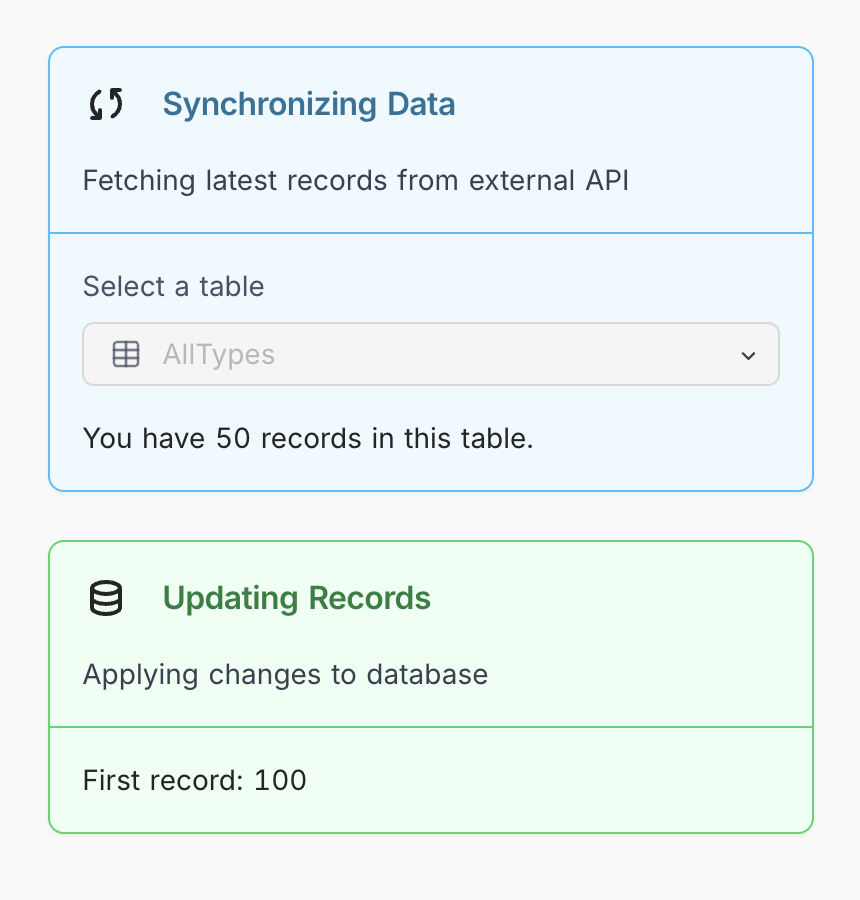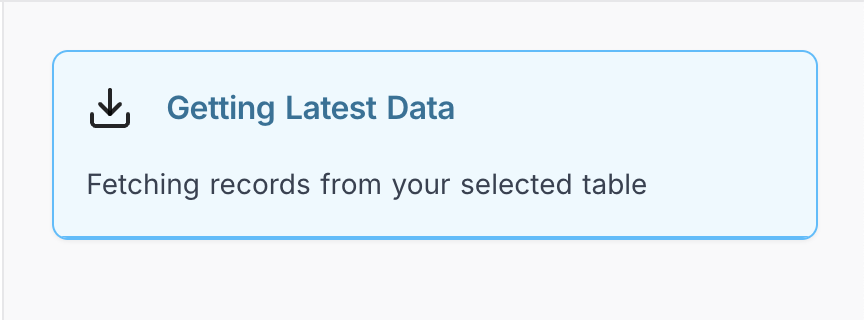Script Steps
Visually guide users through your script with clear subsections
Script Steps let your users see what’s happening while your script runs—making complex operations easier to follow with clear, real-time visual subsections.
Instead of a blank screen, users get progress feedback through titled steps, icons, colors, and descriptions—bringing transparency, trust, and a polished experience.

Basic Step
Add a step with just a title:
script.step('Loading your data...');
Detailed Step
Enhance the step with optional visuals:
script.step({
title: 'Getting Latest Data',
description: 'Fetching records from your selected table',
color: 'blue',
icon: 'download'
});
Customization Options
Colors
Use colors to indicate the type of action:
| Color | Use Case |
|---|---|
blue | General info, loading data |
green | Success, completed actions |
yellow | Validation, warnings |
red | Errors, critical issues |
purple | Special or custom operations |
orange | Updates or changes |
gray | Background or neutral operations |
Icons
Suggested icons for common use cases:
| Icon | Meaning |
|---|---|
download | Fetching or retrieving data |
upload | Sending or submitting data |
database | Interacting with tables |
sync | Updating or syncing |
checkCircle | Completion or success |
settings | Configuration steps |
mail | Email-related actions |
Full Example
Here’s a complete example that guides the user through an import process:
// Step 1: Start import
script.step({
title: 'Starting Import',
description: 'Preparing to import customer data',
color: 'blue',
icon: 'database'
});
const sourceTable = await input.tableAsync('Which table has your customer data?');
const targetTable = await input.tableAsync('Which table should we import to?');
// Step 2: Validate data
script.step({
title: 'Checking Your Data',
description: 'Making sure the data will import correctly',
color: 'yellow',
icon: 'checkCircle'
});
const sourceRecords = await sourceTable.selectRecordsAsync();
if (sourceRecords.length === 0) {
output.text('No records found to import!');
return;
}
// Step 3: Import records
script.step({
title: 'Importing Records',
description: `Moving ${sourceRecords.length} customer records`,
color: 'purple',
icon: 'sync'
});
const newRecords = sourceRecords.map(record => ({
'Customer Name': record.getCellValue('Name'),
'Email': record.getCellValue('Email'),
'Import Date': new Date()
}));
await targetTable.createRecordsAsync(newRecords);
// Step 4: Finish
script.step({
title: 'Import Complete',
description: `Successfully imported ${newRecords.length} customers`,
color: 'green',
icon: 'checkCircle'
});
script.clear();
output.text(`✅ Done! Imported ${newRecords.length} customer records.`);Advanced Usage
Manually Clear a Step
Steps auto-clear when a new one starts, but you can also clear them explicitly:
script.step('Processing...');
await someAsyncTask();
script.clear();Handling Errors Gracefully
Show errors in context to keep users informed:
script.step({
title: 'Sending Emails',
description: 'Notifying customers about their orders',
color: 'blue',
icon: 'mail'
});
try {
await sendEmails();
script.step({
title: 'Emails Sent',
description: 'All customers have been notified',
color: 'green',
icon: 'checkCircle'
});
} catch (err) {
script.step({
title: 'Email Error',
description: 'Could not send some emails – check your settings',
color: 'red',
icon: 'alert'
});
}Best practices
Step Titles
Use descriptive, action-based titles:
| ✅ Do | 🚫 Avoid |
|---|---|
| "Loading customer data" | "Step 1" |
| "Sending invoices" | "Processing" |
| "Updating inventory" | "Working" |
When to Use Steps
Use script steps to improve clarity in:
- Long-running operations (API calls, imports, etc.)
- Multi-phase workflows (setup → validate → process → complete)
- Any place where user feedback improves trust
Avoid steps for very fast or trivial operations that don’t need explanation.
How Many Steps?
- 3–7 steps is ideal for most scripts
- Too few → lack of visibility
- Too many → unnecessary noise
Step Descriptions
Explain what’s happening, not how it’s implemented:
| ✅ Good | 🚫 Avoid |
|---|---|
| "Fetching latest orders from your store" | "Calling API endpoint with headers" |